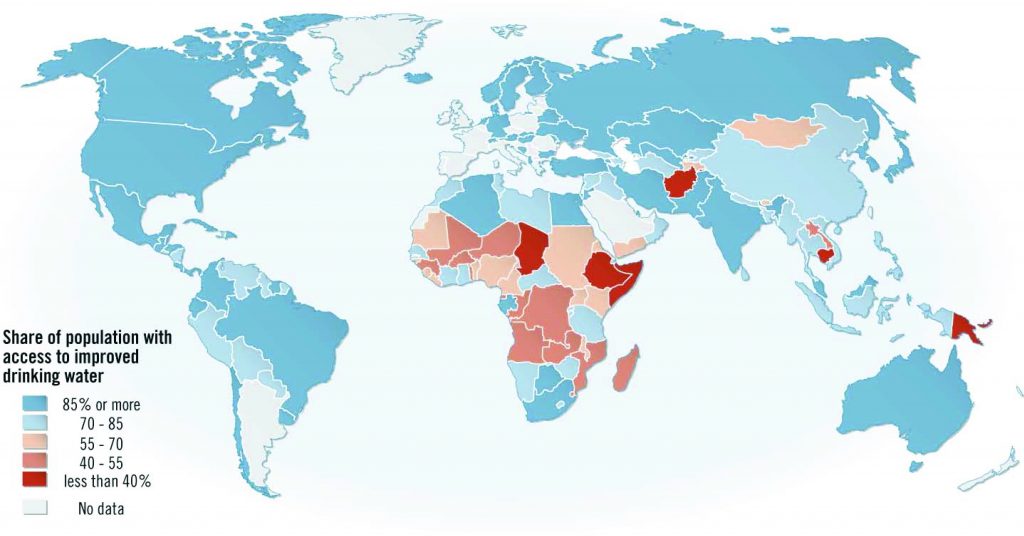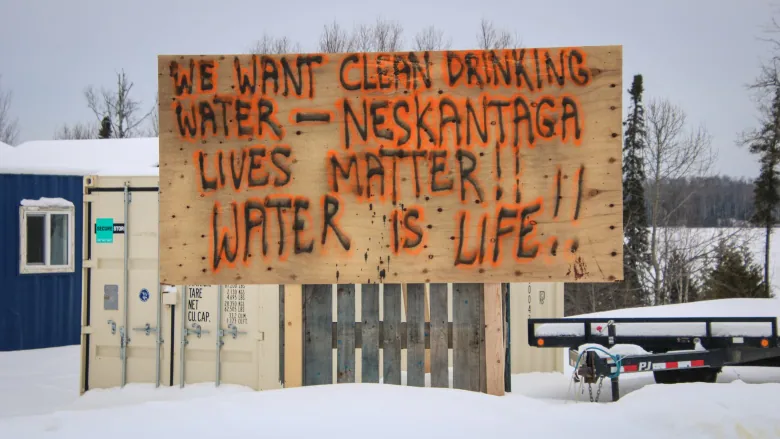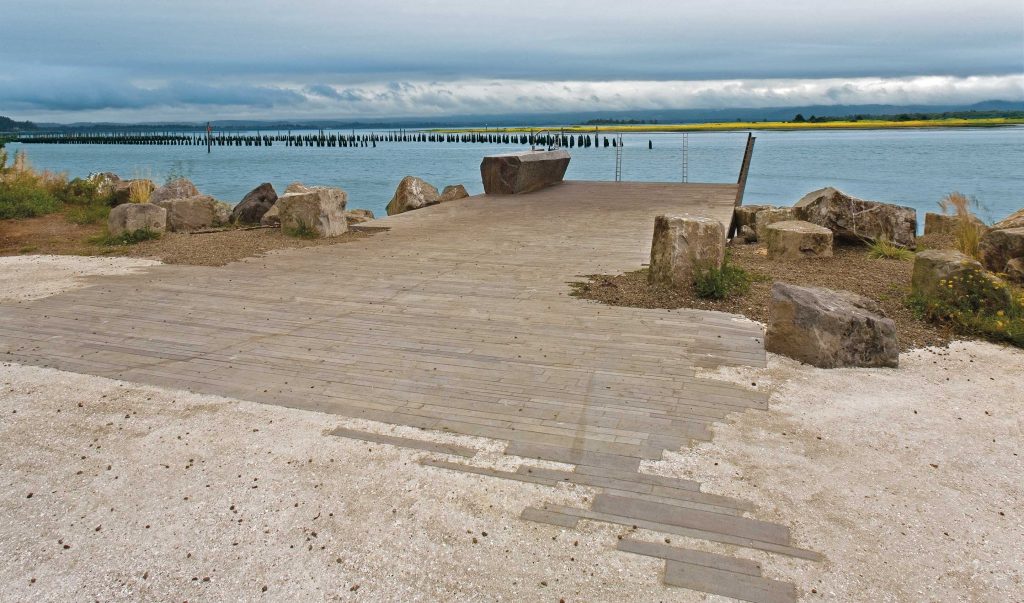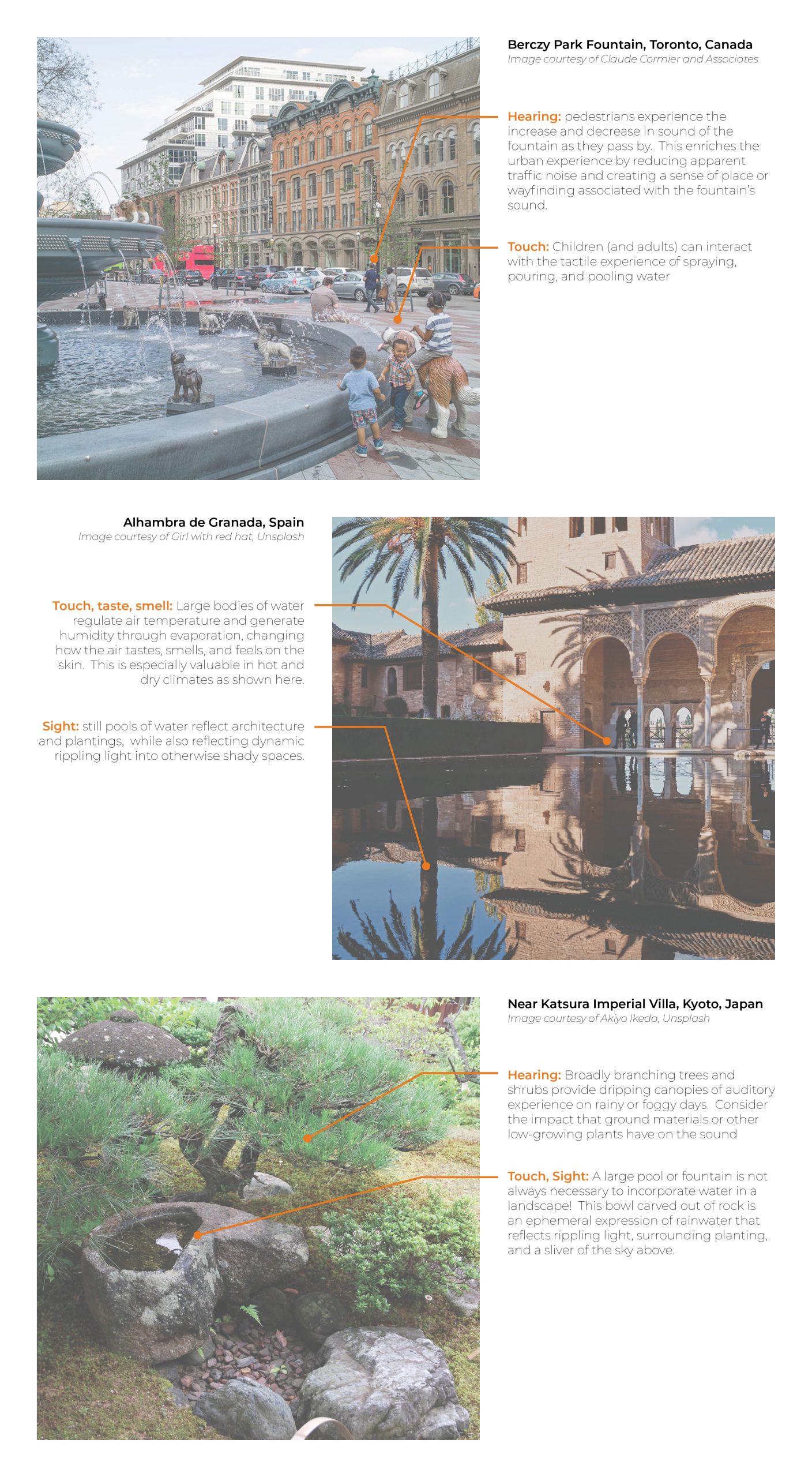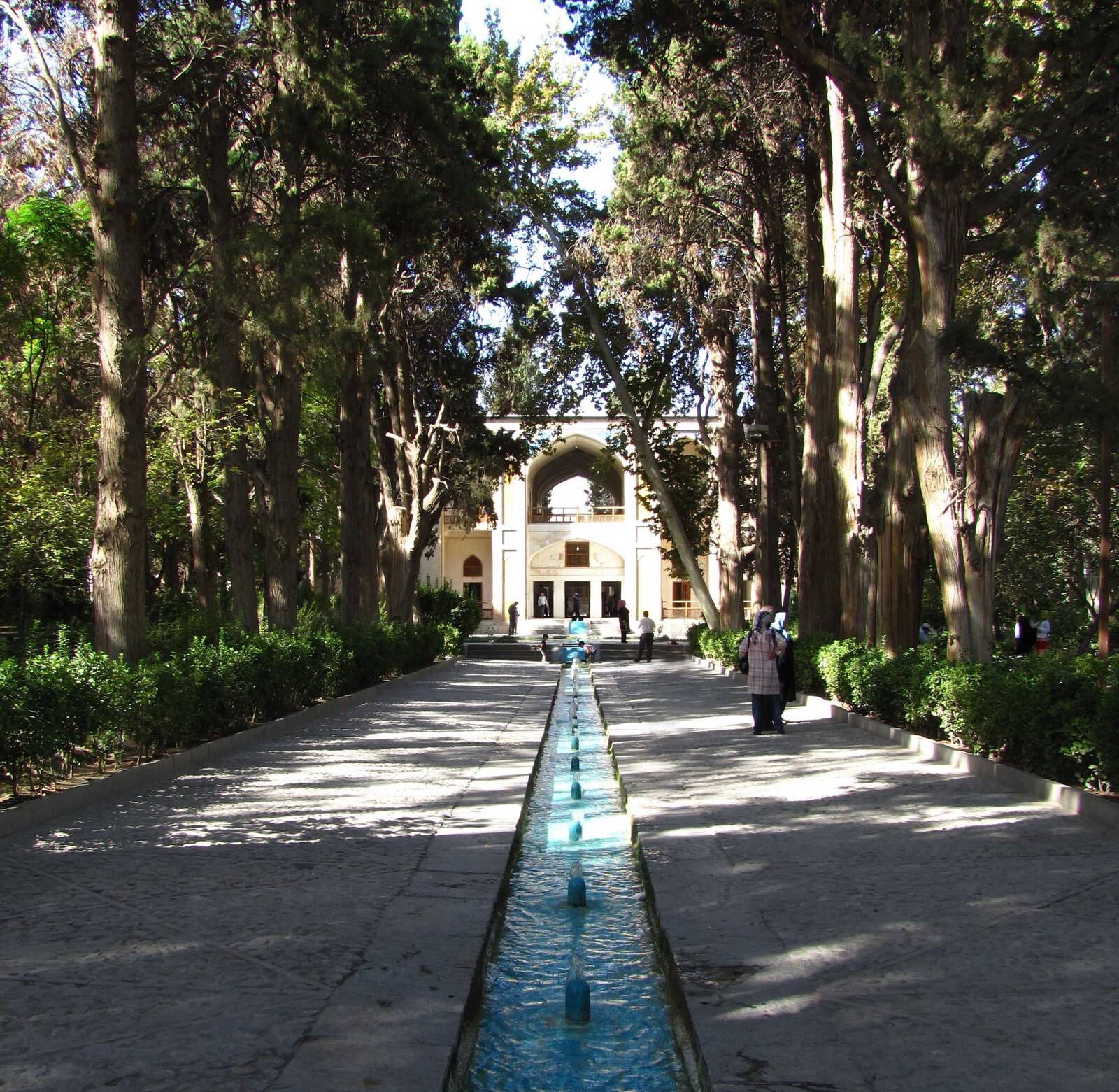While issues of water quality are often seen as a large-scale problem for engineers and planners, designers working in landscape and architecture have a significant role to play. It is critical to understand that the quality of water is not only determined by the presence or absence of contaminants, but also by temperature, presence or absence of valuable nutrients and minerals, and even the speed of flow or current.
Why is Water Quality Important?
Ecosystems and the organisms within them affect and are affected by water quality. Changes to a healthy water quality regime – or to the surrounding ecosystem – almost always result in detrimental, trickle-down impacts.
For example, numerically minor changes to ocean temperature, salinity, and pH balance brought about by global warming have been responsible for major bleaching events of coral, to the extent that some experts believe the unique reef ecosystems they uphold may disappear within our lifetime1.
Along the pacific coast of North America, research has shown that overfishing may not be the prime culprit in the depletion and destruction of local salmon fisheries. Rather, 200 years of colonial industry, damming, forestry, and agriculture with insufficient regulation have contaminated, blocked, rerouted, increased water temperature, and introduced significant sediment loads to watersheds, upsetting the delicate habitat that salmon require to spawn2.
For humans, fresh water is one of the most valuable resources in the world. We rely on potable, fresh water not just for our life, health and hygiene, but also for industry, technology, and agriculture. A key global indicator of wealth and poverty – and in turn, of marginalization and power – is the level of access to clean drinking water (see The Ethics of Water). Billions of dollars and significant amounts of energy are spent each year on active purification of water for drinking, usually through complex, engineered systems of varying scales.
Landscape Architects and Architects have a responsibility to design spaces that contribute to ideal water quality for humans and the ecosystems in which we inhabit.
1. Moseman, “What Would Happen If We Lost All Coral Reefs?”
2. Lichatowich, Salmon without Rivers: A History of the Pacific Salmon Crisis.
What factors contribute to water quality reduction?
Reduction in water quality can be caused by numerous factors. The following examples are not exhaustive but provide a starting point for inquiry into a site’s water quality history.
Contamination: For Designers, contamination by human sources is one of the most critical concerns. Water is one of the primary vehicles by which contaminants spread from a single source location. Gas stations, dry cleaners, mechanics, industrial facilities, agriculture, and resource extraction operations are well-known producers of water-born contaminants; however, research has shown that roadways, home cleaning supplies, and lawncare contributes significantly to a watershed’s contaminant load1. See the following table for a list of water-borne contaminants associated with likely sources.
One of the most typical contaminant sources in urban areas is the sewer system. For thousands of years, humans have used rivers and tides to carry away human waste, and despite technological advancement, many sewer systems today are outdated and under stress from population growth. Combined storm-sewer systems often have emergency outfalls in oceans, rivers, or lakes. In rainfall or flooding events that overload the water treatment facility, these outfalls discharge an untreated mixture of contaminated runoff and sewage into these natural waterways causing catastrophic outcomes.
Nutrient levels: nutrient levels in bodies of water must be balanced according to the needs of the ecosystem. Nutrient depletion can occur when activity around a watershed prevents some sort of typical nutrient input. Overabundance of nutrients, also called eutrophication, can occur when activity around a watershed adds additional nutrient inputs to the system. One common cause of eutrophication in watersheds is high-intensity agriculture, wherein nitrogen and phosphorous applied to fields as fertilizer make their way through run-off into surrounding water bodies. Another cause is human or animal waste finding its way into waterways from septic systems, livestock farms, and water treatment facilities. A typical sign of eutrophication in water is the presence of algae blooms, which feed on overabundant nutrients and can in turn wreak havoc on aquatic ecosystems.
Oxygen: Dissolved oxygen in water is critical for the health of aquatic organisms. After algae blooms caused by eutrophication, decomposing algae is fed on by bacteria that can quickly use up dissolved oxygen. Water with resulting very low oxygen levels is called hypoxic2. Oxygen is dissolved in water through surface water movement and the release of oxygen from aquatic plants performing photosynthesis3. Damming or channeling of moving water, or removal of aquatic plants can also reduce oxygen levels
Sediment Loads: Disturbance in riparian areas due to resource extraction, development, and agriculture can result in watersheds being choked by sediment. Many aquatic organisms rely on specific balances of sediment for habitat, sunlight, visibility, food sources, and reproduction, and changes to these balances can be catastrophic. Sediment in flowing water also has the potential to carry contaminants long distances from sources before releasing them4.
Temperature change: Water temperature is a very important aspect of ecosystem balance. Small changes of water temperature over short time scales can even result in ecosystem collapse. These temperature changes can occur as a result of global warming, heat waves, and sediment loads. A major culprit in increased water temperature in streams and rivers is the reduction of shade from trees and other plants in riparian areas that leave shallow water exposed to direct sun for longer portions of the day. (Bowler et al. 2012)
1. Kennen and Kirkwood, Phyto: Principles and Resources for Site Remediation and Landscape Design.
2. “Nutrients and Eutrophication.”
3. Marcy et al., “Dissolved Oxygen.”
4. Canada, “Water Pollution.”
5. Bowler et al., “What Are the Effects of Wooded Riparian Zones on Stream Temperature?”
What factors contribute to remediation?
In many cases, landscape architects and architects must actively remediate existing contaminants and contaminant sources through design. Even small-scale projects can have a significant impact on the health of watersheds and coastal ecosystems (see precedents below). The following strategies, among others, are at a designer’s disposal:
Mechanical filtration: This is the most common method used to prevent contaminants, especially larger, visible contaminants, from entering water bodies or drinking water. There are hundreds of filtration systems used in applications from rainwater management to pool filtration. Sediment traps, which can be manufactured elements or simple depressions in the landscape are used in rainwater management to prevent large debris and silt in run-off from entering the watershed. Sand and activated charcoal filters are commonly used in pools and water treatment facilities to filter out suspended particles and organic compounds. Membrane filtration is often used in drinking water treatment and wastewater treatment as it is also able to remove bacteria and viruses.
Phytoremediation: The use of plants to clean water and soil, or phytoremediation, has seen renewed interest in recent years. Research has shown that certain plants have unique abilities to extract, store, and even disable contaminants. Typical applications include bioswales and engineered wetlands, where specific plant combinations are selected to filter out contaminants from urban runoff. Phytoremediation can also be applied more specifically, by understanding the contaminants present on site and selecting plants that are uniquely suited to manage those specific compounds or elements. Additional reading in Phyto: Principles and Resources for Site Remediation and Landscape Design1 is highly recommended as a starting point to understand this complex yet promising new area of research.
Phytoremediation is also a present factor in the burgeoning field of natural swimming pools. Here, aquatic plants are used alongside mechanical filtration systems to re-cycle pool water, removing contaminants and particles along the way without the use of harmful chemicals such as chlorine2.
Purification: purification of water is usually only required when the water must be potable. To purify water, chemicals or additional processes are introduced alongside mechanical filtration to ensure contaminants and microscopic organisms are removed. Many of the chemicals used to improve the quality of drinking water are contaminants themselves when released into natural systems, highlighting that water quality is always relative according to context.
1. Kennen and Kirkwood, Phyto: Principles and Resources for Site Remediation and Landscape Design.
2. HCMA, “Natural Swimming Pools: The Future of Public Swimming without Chlorine.”
What factors contribute to maintaining good water quality?
On all sites, including those that are not contaminated, landscape architects and architects have a responsibility to do no harm to existing water quality through their work. The following strategies should be employed in the design process:
Understanding water regime: It is critical that designers have a thorough understanding of the way water moves above, at, and below grade at – and around – each unique site. During preliminary design, the impact of interventions on the water regime should be examined.
Respecting Riparian Areas: If a given site is located close to a body of water, riparian ecological areas should be protected or enhanced. Most jurisdictions have extensive requirements associated with development alongside water bodies that aim to protect water quality and surrounding ecosystems. In many cases, designers will work alongside registered environmental professionals and biologists to ensure that their work complies. Protection of existing vegetation or planting of additional vegetation along streams is particularly important, as plants help shade shallow water, provide habitat for the prey of aquatic animals, maintain bank stability, and reduce sediment levels in runoff.
Preventing spread of waterborne contaminants: Though a site may not contain water-borne contaminants, it is important to take steps to ensure that any contaminants from surrounding sites, future contamination, or novel sources are not able to pass through. Vegetation cover is particularly useful for preventing the spread of unexpected contamination into ground water. Green roofs and bioswales filter surface run-off for potential contaminants from roofing materials and paved surfaces. Certain trees such as poplars have a high transpiration rate and deep roots, which can slow and lessen the flow of groundwater that has the potential to carry contaminants. Otherwise, simply managing water at grade rather than in pipes below ground helps maintain visibility of water on site (see Rainwater Management), leading to easier discovery of possible contaminants.
Ensuring optimal oxygen and nutrient levels: Certain aquatic ecosystems require specific oxygen and nutrient levels, and there are many methods by which environmental designers can increase or decrease these levels through intervention and maintenance plans. For example, if oxygen levels are low, introducing aquatic plants (ensure these are not invasive), installing bubblers and fountains, or designing waterfalls and rapids can increase levels to a healthy point. If nutrient levels in a pond are too high, consider maintenance regimes that reduce the amount of decomposing plant matter in the water, and plant species that do not require additional fertilization in areas upslope from the pond.
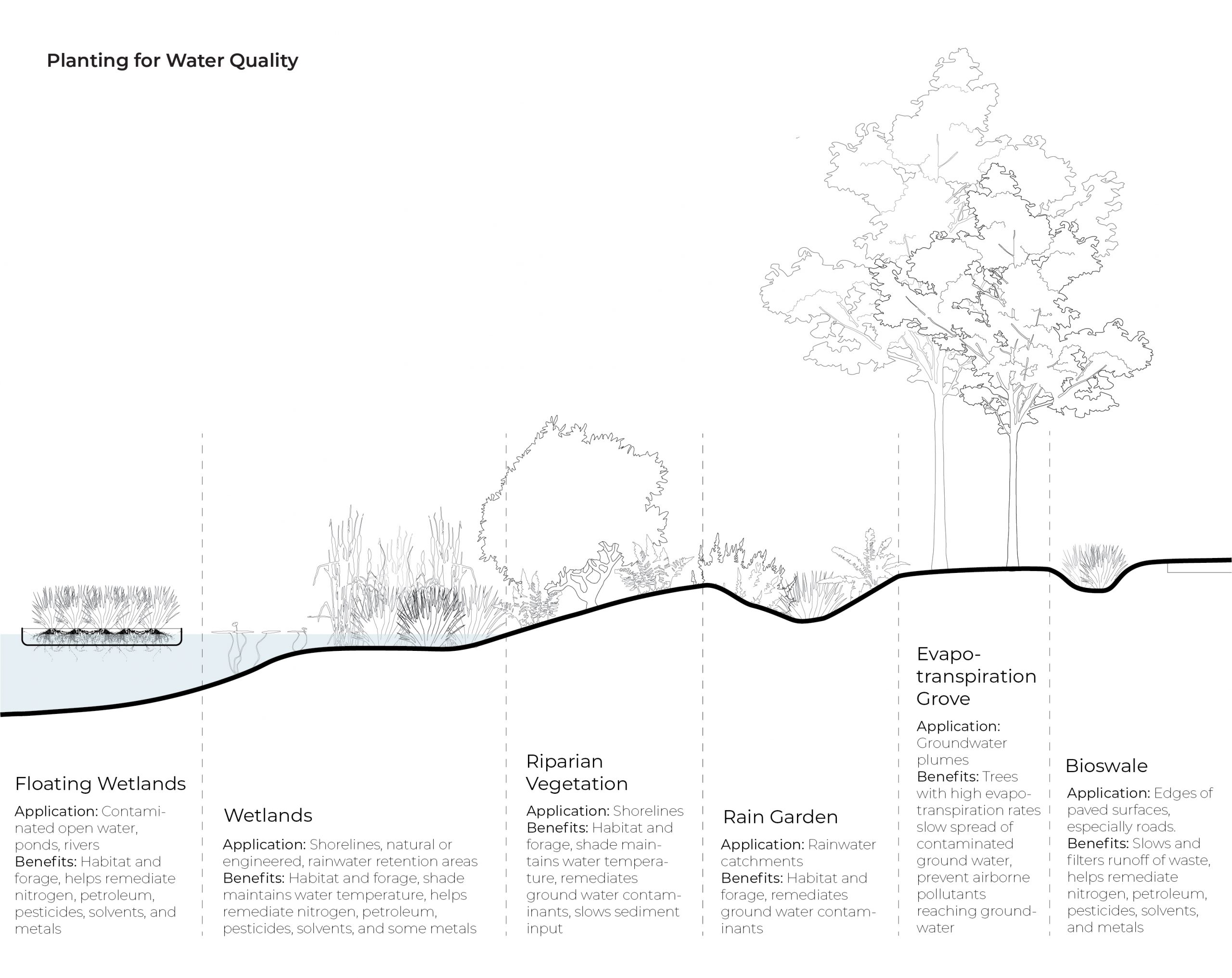
Figure 1: Planting for Water Quality.
Sources
“Nutrients and Eutrophication | U.S. Geological Survey.” https://www.usgs.gov/mission-areas/water-resources/science/nutrients-and-eutrophication.
Atlas Scientific. “Water Purification Methods,” May 24, 2022. https://atlas-scientific.com/blog/water-purification-methods/.
Canada, Environment and Climate Change. “Water Pollution: Erosion and Sedimentation.” Guidance, January 9, 2007. https://www.canada.ca/en/environment-climate-change/services/water-overview/pollution-causes-effects/erosion-sedimentation.html.
Moseman, Andrew. “What Would Happen If We Lost All Coral Reefs? | MIT Climate Portal.” MIT Climate Portal, November 16, 2023. https://climate.mit.edu/ask-mit/what-would-happen-if-we-lost-all-coral-reefs.
Lichatowich, James A. Salmon without rivers: A history of the pacific salmon crisis. Washington, DC: Island Press, 1999.
Kennen, Kate, and Niall Kirkwood. Phyto: Principles and resources for site remediation and landscape design. New York: Routledge, 2017.
Marcy, Suzanne M, Glenn Suter II, and Susan Cormier. “Dissolved Oxygen.” US EPA Data and Tools, November 4, 2015. https://www.epa.gov/caddis-vol2/dissolved-oxygen.
HCMA. Natural Swimming Pools: The Future of Public Swimming without Chlorine. HCMA, 2016. https://hcma.ca/wp-content/uploads/2016/04/Natural-Swimming-Pools-Report_HCMA.pdf
Bowler, Diana E., Rebecca Mant, Harriet Orr, David M. Hannah, and Andrew S. Pullin. “What Are the Effects of Wooded Riparian Zones on Stream Temperature?” Environmental Evidence 1, no. 1 (May 1, 2012): 3. https://doi.org/10.1186/2047-2382-1-3.
Additional Resources
Kennen, Kate, and Niall Kirkwood. Phyto: Principles and resources for site remediation and landscape design. New York: Routledge, 2017.
This is a highly recommended resource for all environmental designers, outlining the science of phytoremediation to its cutting edge (including plant lists, contaminant tables, and precedents), while providing practical takeaways for environmental designers with beautiful and informative graphics.
HCMA. Natural Swimming Pools: The Future of Public Swimming without Chlorine. HCMA, 2016. https://hcma.ca/wp-content/uploads/2016/04/Natural-Swimming-Pools-Report_HCMA.pdf
Natural swimming pools are a continuously developing technology that this document outlines in an easy-to-understand way.
Precedents
Vintondale Reclamation Park: DIRT Studio
Vintondale, Pennsylvania, USA
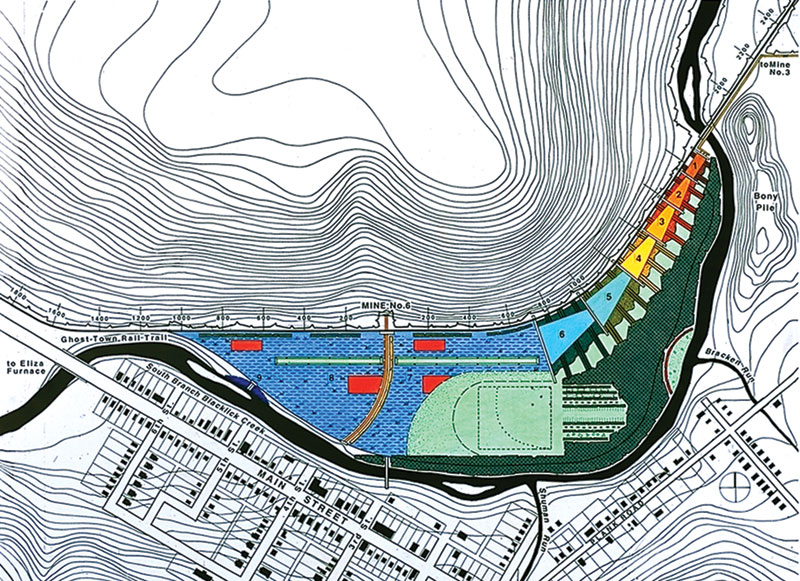
Vintondale Reclamation Park seeks to make visible the process by which toxic acid mine drainage is cleaned from the waters of Blacklick Creek, at the site of an abandoned coal mine.
The project can be viewed here.
Parque Rachel de Queiroz: Architectus S/S
Fortaleza, Brazil
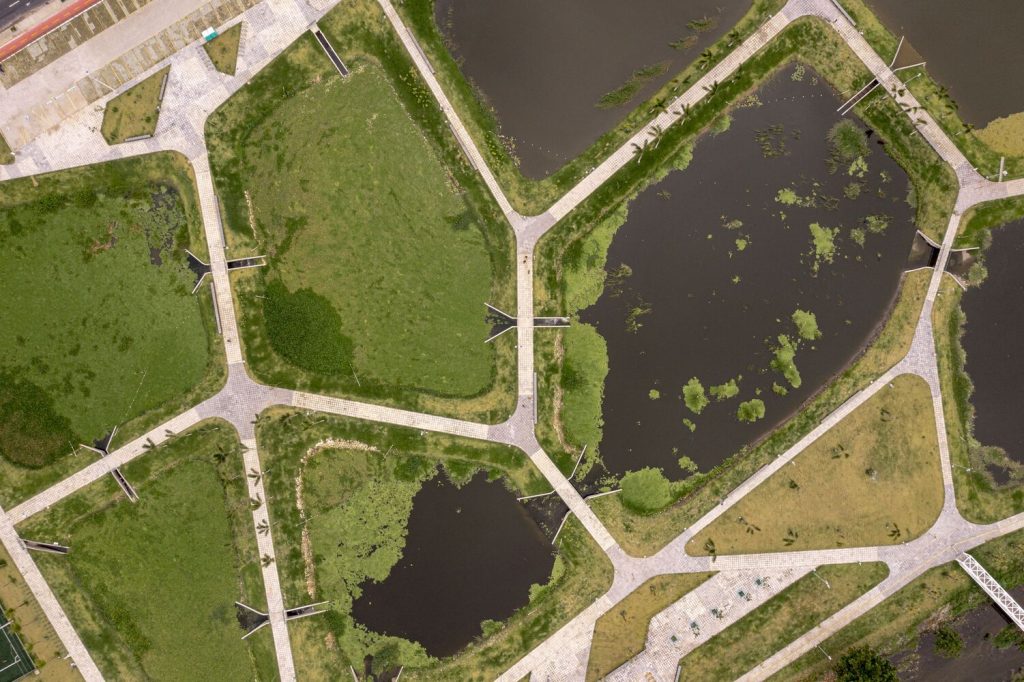
Parque Rachel de Queiroz interweaves recreation and water quality and flooding control in the middle of an urban center. “After intensive hydrological studies, nine interconnected ponds were proposed to perform a natural water filtering process through decanting and phytoremediation. This process is conducted by microorganisms fixed both on the surface of the soil and on the roots of aquatic plants in the ponds.”
The project can be viewed here.

